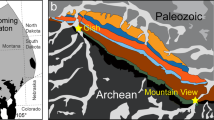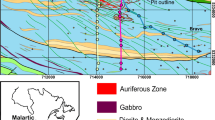Abstract
Oxygen isotope compositions of whole rock specimens and mineral separates from the Cuillins Gabbro Complex, Isle of Skye, Scotland, are employed to determine the patterns and processes of18O depletion in the Outer Unlayered Gabbro (OUG) and associated dikes. Whole rockδ 18O values range from +4.8 to −1.1‰ (SMOW) and dikeδ 18O values range from +4.7 to −2.8‰ Mineral separates from three OUG samples yieldδ 18O values from +5.3 to +4.8‰ for augite and +4.1 to +0.8‰ for plagioclase. An early, small-scale hydrothermal circulation system was initiated by the OUG prior to the large-scale hydrothermal convection established by the later Layered Cuillins Complex (LCC). Dikes were emplaced in the OUG after intrusion of the LCC and had only a minor effect on hydrothermal circulation in the OUG. There is evidence of enhanced fluid flow along dike/gabbro contacts. Isotopic compositions of augite separates demonstrate a normalδ 18O value for the OUG magma with all18O depletion in the OUG due to subsolidus exchange processes including diffusion and surface reaction. The mineral separates yield a pattern of18O depletion consistent with a diffusion mechanism, the bulk of the exchange having occurred in the plagioclase. Secondary mineral formation played a subordinate role in the18O depletion of the OUG. The calculated water to rock mass ratio necessary to effect the observed18O depletion in the OUG is on the order of 0.2, although a much greater amount of water circulation probably occurred. The cooling duration required to explain the measured18O depletion in the OUG by diffusion is very short (140 years at 750° C, 2400 years at 550° C) compared to the duration necessary for pure conductive cooling (105 to 106 years). Rapid local cooling rates in the OUG due to meteoric water convection are consistent with the observed18O depletion in OUG samples.
Similar content being viewed by others
References
Bethke PM, Rye RO (1979) Environment of ore deposition in the Creede mining district, San Juan Mountains, Colorado, IV. Sources of fluids from oxygen hydrogen and carbon isotope studies. Econ Geol 74:1832–1851
Brown GM (1969) The Tertiary igneous geology of the Isle of Skye. The Geologists Assoc, Guide 13, London
Carslaw HS, Jaeger JC (1959) Conduction of heat in solids. Oxford University Press, Oxford, pp 510
Casadevall T, Ohmoto H (1977) Sunnyside mine, Eureka mining district, San Juan County, Colorado: geochemistry of gold and base metal ore deposition in a volcanic environment. Econ Geol 72:1285–1320
Clayton RN, Mayeda TK (1963) The use of bromine pentafluoride in the extraction of oxygen from oxides and silicates for isotopic analysis. Geochim Cosmochim Acta 27:43–52
Coghlan RA, Giletti BJ (1987) Oxygen transport along high-angle feldspar-feldspar grain boundaries. EOS 68:417
Cole DR, Ohmoto H, Lasaga AC (1983) Isotopic exchange in mineral-fluid systems. I. Theoretical evaluation of oxygen isotopic exchange accompanying surface reactions and diffusion. Geochim Cosmochim Acta 47:1681–1693
Crank J (1956) The mathematics of diffusion. Oxford Press, London, pp 547
Criss RE, Taylor HP Jr (1986) Meteoric-hydrothermal systems. In: Valley JW, Taylor HP Jr, O'Neil JR (eds) Stable isotopes in high temperature geological processes. Mineral Soc Am Washington, pp 313–424
Crowley JC, Giletti BJ (1983) Patterns of oxygen isotope depletion, multiple hydrothermal circulation systems, and the cooling history of the Stony Mountain intrusive complex, Colorado. Earth Planet Sci Lett 64:231–243
Dodson MH (1973) Closure temperature in cooling geochronological and petrological systems. Contrib Mineral Petrol 40:259–274
Drury SA, Frances PW, Gass IG, Jackson DE, Melton LRA, Pearce JA, Thorpe RS, Williams DW, Wilson RCL (1976) Igneous case study. The Tertiary igneous rocks of Skye, NW Scotland. The Open University Press, Milton Keynes, pp 88
Evans AL (1969) On dating the British Tertiary igneous province. PhD thesis, University of Cambridge
Farver JR, Giletti BJ (1987) Oxygen diffusion in diopside and the timing of18O depletion in a hydrothermal circulation system, Cuillins Gabbro Complex, Isle of Skye, Scotland. EOS 68:1528
Farver JR (1989) Oxygen self-diffusion in diopside with application to cooling rate determinations. Earth Planet Sci Lett (in press)
Ferry JM (1985) Hydrothermal alteration of Tertiary igneous rocks from the Isle of Skye, northwest Scotland. I. Gabbros. Contrib Mineral Petrol 91:264–282
Forester RW, Taylor HP Jr (1976)18O depleted igneous rocks from the Tertiary igneous complex of Mull, Scotland. Earth Planet Sci Lett 32:11–17
Forester RW, Taylor HP Jr (1977)18O/16O, D/H, and13C/12C studies of the Tertiary igneous complex of Skye, Scotland. Am J Sci 277:136–177
Forester RW, Taylor HP Jr (1980) Oxygen, hydrogen, and carbon isotope studies of the Stony Mountain Complex, western San Juan Mountains, Colorado. Econ Geol 75:362–383
Giletti BJ, Semet MP, Yund RA (1978) Studies in diffusion, III. Oxygen in feldspars: an ion microprobe determination. Geochim Cosmochim Acta 42:45–57
Harker A (1904) The Tertiary igneous rocks of Skye. Geol Sur Gr Britain Mem, J Hedderebeck & Sons for His Majesty's Stationary Office, Glasgow, pp 481
Ito E, Brown JL, Giletti BJ (1986) Sequential hydrothermal episodes recorded by oxygen isotopes in the Cuillins Gabbro, Isle of Skye, Scotland. EOS 67:399
Moorbath S, Bell JD (1965) Strontium isotope abundance studied and rubidium-strontium age determinations on Tertiary igneous rocks from the Isle of Skye, northwest Scotland. Earth Planet Sci Lett 5:217–230
Norton D, Taylor HP Jr (1979) Quantitative simulation of the hydrothermal systems of crystallizing magmas on the basis of transport theory and oxygen isotope data: an analysis of the Skaergaard intrusion. J Petrol 20:421–486
O'Neil JR, Taylor HP Jr (1967) The oxygen isotope and cation exchange chemistry of feldspar. Am Mineral 52:1414–1437
Parmentier EM (1981) Numerical experiments on18O depletion in igneous intrusions cooling by groundwater convection. J Geophys Res 86:7131–7144
Richey JE (1961) Scotland: the Tertiary volcanic districts. In: British Regional Geology, 3rd edition. Her Majesty's Stationary Office, Edinburgh, pp 120
Taylor HP Jr (1968) The oxygen isotope geochemistry of igneous rocks. Contrib Mineral Petrol 19:1–71
Taylor HP Jr (1971) Oxygen isotope evidence for large scale interaction between meteoric groundwaters and Tertiary granodiorite inclusions, Western Cascades Range, Oregon. J Geophys Res 76:7855–7874
Taylor HP Jr (1973)18O/16O evidence for meteoric-hydrothermal alteration and ore deposition in the Tonopah Comstock Lode, and Goldfield mining districts, Nevada. Econ Geol 68:747–764
Taylor HP Jr (1974a) Oxygen and hydrogen isotope evidence for large scale circulation and interaction between groundwaters and igneous intrusions with particular reference to the San Juan Volcanic Field, Colorado. In: Hofmann AW, Giletti BJ, Yoder HS Jr, Yund RA (eds) Geochemical transport and kinetics. Carnegie Inst Washington Publ 634:299–324
Taylor HP Jr (1974b) The application of oxygen and hydrogen isotope studies to problems of hydrothermal alteration and ore deposition. Econ Geol 69:843–883
Taylor HP Jr (1977) Water/rock interactions and the origin of H2O in granitic batholiths. J Geol Soc London 133:509–558
Taylor HP Jr, Forester RW (1971) Low-18O igneous rocks from the intrusive complexes of Skye, Mull, and Ardnamurchan, western Scotland. J Petrol 12:465–497
Taylor HP Jr, Forester RW (1979) An oxygen and hydrogen study of the Skaergaard intrusion and its country rocks: a description of a 55-my old fossil hydrothermal system. J Petrol 20:355–419
Thompson RN (1981) The Tertiary Province: Geochemistry and magma genesis. In: Sutherland DS (ed) Igneous rocks of the British Isles. Wiley, New York, pp 461–477
Thompson RN (1982) Magmatism of the British Tertiary Volcanic Province. Scott J Geol 18:49–107
Wager LR, Brown GM (1967) Layered igneous rocks. Freeman, San Francisco, pp 588
Williams AE (1980) Investigation of oxygen-18 depletion of igneous rocks and ancient meteoric-hydrothermal circulation in the Alamosa River stock region, Colorado. PhD thesis, Brown University
Author information
Authors and Affiliations
Rights and permissions
About this article
Cite this article
Farver, J.R., Giletti, B.J. Patterns and processes of oxygen isotope exchange in a fossil meteoric hydrothermal system, Cuillins Gabbro Complex, Isle of Skye, Scotland. Contr. Mineral. and Petrol. 102, 24–33 (1989). https://doi.org/10.1007/BF01160188
Received:
Accepted:
Issue Date:
DOI: https://doi.org/10.1007/BF01160188




